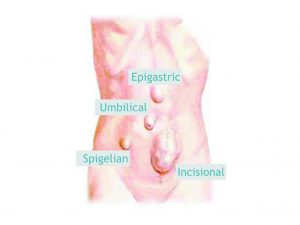By George Rossidis, MD, FACS Minimally Invasive Surgeons of Ocala
 What is an abdominal wall hernia?
What is an abdominal wall hernia?
Your internal organs and tissues are held in place by a tough outer wall of tissue called the “abdominal wall.” An abdominal hernia is an area in that wall that is weak or torn. Often when there is a hernia, organs or tissues that are normally held in place by the abdominal wall bulge or stick out through the weak or torn spot. There are many different kinds of abdominal wall hernias.
Epigastric hernias are defects in the abdominal midline between the umbilicus and the xiphoid process. Incisional hernias, by definition, develop at sites where an incision has been made for some prior abdominal procedure. Groin hernias, including inguinal and femoral hernias, are the most common abdominal wall hernias. Umbilical hernias occur at the belly button and are associated with increased intra-abdominal pressure due to obesity, abdominal distension, ascites, and pregnancy. A Spigelian hernia occurs at the lateral edge of the rectus abdominis, due to the absence of posterior reinforcement to the muscle. It is diagnosed far less frequently than the other described hernias.
What are the symptoms of abdominal wall hernias? Abdominal wall hernias do not always cause symptoms. When they do, they can cause some or all of these symptoms:
. A bulge somewhere on the trunk of the body. This bulge can be so small that you don’t even realize it’s there.
. Pain, especially when coughing, straining, or using nearby muscles
. A pulling sensation around the bulge
Abdominal wall hernias can balloon out and form a sac. That sac can end up holding a loop of intestine or a piece of fat that should normally be tucked inside the belly. This can be painful and even dangerous if the tissue in the hernia gets trapped and unable to slide back into the belly. When this happens, the tissue does not get enough blood, so it can become swollen or even die.
Should I see a doctor or nurse?
Yes. See a doctor or nurse if you have any symptoms of a hernia. In most cases, doctors can diagnose a hernia just by doing an exam. During the exam, the doctor might ask you to cough or bear down while pressing on your hernia. This might be uncomfortable, but it is necessary to find the source of the problem. Most of the time, the contents of the hernia can be “reduced,” or gently pushed back into the belly. Still, there are times when the hernia gets trapped and won’t go back in. If that happens, the tissue that is trapped can get damaged. If you develop pain around a hernia bulge or feel sick, call your doctor or surgeon right away. For patients in whom abdominal wall hernia is suspected but not apparent clinically, further imaging is suggested, the nature of which depends upon the location of the suspected hernia.
How are hernias treated?
Not all hernias need treatment right away. But many do need to be repaired with surgery. Surgeons can repair most hernias in two ways. The right surgery for you will depend on the size of your hernia, where on the abdominal wall it is, whether this is the first time it is getting repaired, and what your general health is like.
The types of surgery are:
Open surgery – During an open surgery, the surgeon makes an incision near the hernia. Then he or she looks at the tissue that is stuck in the hernia, and if it is healthy, gently pushes it back into place. Sometimes a piece of tissue needs to be removed. Next, the surgeon sews the layers of the abdominal wall back together, so that nothing can bulge through. In some cases, surgeons will also patch the area with a piece of mesh. The mesh takes some of the strain off the abdominal wall. That way the hernia is less likely to happen again.
Laparoscopic surgery – During laparoscopic surgery, the surgeon makes a few incisions that are much smaller than those used in open surgery. Then he or she inserts long, thin tools into the area near the hernia. One of the tools has a camera (called a “laparoscope”) on the end, which sends pictures to a TV screen. The surgeon can look at the picture on the screen to guide his or her movements. Then he or she uses the long tools to repair the hernia using mesh.
Robotic surgery – Robotic surgery uses the same principles of laparoscopic surgery (use of a laparoscope and performing the surgery looking at a screen) but the thin tools used in this case are operated by a robot to provide better manual dexterity.
If your hernia has reduced the blood supply to a loop of intestine, your doctor might need to remove that piece of intestine. Then he or she will sew the intestine back together.
In general, laparoscopic and robotic approaches provide decreased morbidity with faster recuperation and faster return to activities and obligations. The recovery and aftercare for each type of hernia repair is different. Your doctor or nurse can tell you what to expect after your surgery. Specific instructions will be provided to you.
ocalahealthsystem.com
Check Also
Recurrent UTIs: Addressing the Risk of Antibiotic Resistance
Urinary tract infections (UTIs) are common bacterial infections that affect millions of individuals worldwide each …
 Central Florida Health and Wellness Magazine Health and Wellness Articles of the Villages
Central Florida Health and Wellness Magazine Health and Wellness Articles of the Villages



